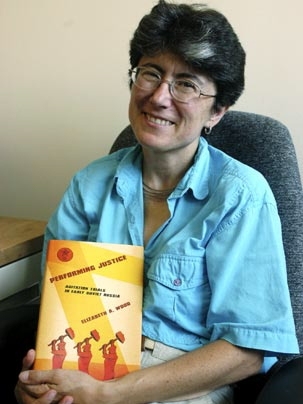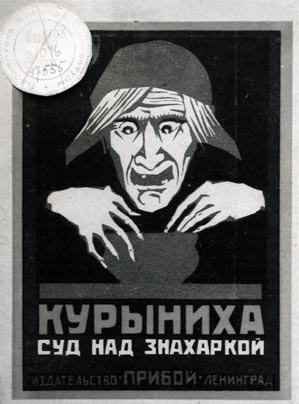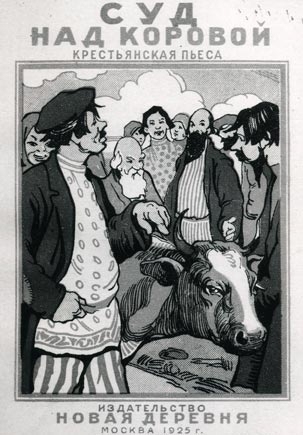Anyone who watches television knows all about courtroom drama. Americans, who eat up everything from "Law and Order" to the Michael Jackson trial, aren't just entertained by trials. They also learn a little something--about Miranda rights, DNA evidence, the importance of having your lawyer present.
Turns out, trials have been used to educate and entertain for a long time.
An MIT historian's delight in scholarly sleuthing has yielded an accessible and timely new book on the use of mock trials in the Soviet Union. Originally developed as educational entertainment--to guide an uneducated populace in the treatment of disease, for example--these trials ultimately gave rise to the infamous Great Purge, which sent many prominent Soviet citizens to exile and death in the 1930s.
Elizabeth Wood, associate professor of history and director of the Women's Studies Program at MIT, is author of "Performing Justice: Agitation Trials in Early Soviet Russia" (Cornell University Press, 2005).
Wood described "Performing Justice" as a "historian's dream to work on--a significant subject with great research materials and echoes that reach into contemporary life."
A Brooklyn, N.Y., native who is fluent in Russian, Wood grew intrigued by her topic while working in St. Petersburg on her previous book, "The Baba and the Comrade: Gender and Politics in Revolutionary Russia" (Indiana University Press, 1997).
"Intensely exciting" was how Wood described the process of unearthing original materials and tracing the religious, political and military roots of "agitation" trials, amateur theatrical productions put on in small, urban clubs between 1919 and 1933 to educate and entertain Soviet workers.
Wood made three "sleuthing" trips, working in St. Petersburg in the summer of 1991 and in Moscow in 1992-1993 and 1996. Each time, she spent hours in former Soviet archives and libraries, seeking and studying 75-year-old pamphlets and internal reports about the early mock trials.
Wood, who is also fluent in French, was often the first person since the early 1920s to open the pamphlets that guided young Red Army soldiers or urban workers on how to produce a mock trial in one of their local clubs. In general, their productions focused on contentious social issues or public health problems. The early defendants were almost always found innocent on the grounds that society had failed to protect and educate them.
"The materials were sewn into folders. I had to figure out what ministry or agency had published the ones I wanted, request them from a librarian or archivist and take notes or try to obtain photocopies," Wood said.
Wood's enthusiasm for her field and her topic served her well, as obstacles abounded. So did grimness. Wood recalled long lines of people waiting for "nothing," unpainted buildings, and gnawing anxiety about the police during her time in the Soviet Union.
In the Soviet years, foreigners were segregated into separate reading rooms; prostitution, a frequent topic of agitation trials, was "not a legal subject," so she could not request documents using the "p-word"; and physical conditions were poor. Even during a post-Soviet visit in 1996, she recalled "working in all my clothes and wearing fingerless gloves," due to the cold inside. The archive had been unable to pay its heating bill.
Persistence and creativity paid off. "Performing Justice" offers detailed descriptions of the culture of everyday life in cities and villages, the position of the military, the problems of illiteracy, prostitution and venereal disease, and the ambivalent role of an entirely new creation, the Soviet woman.
One chapter, "The Trial of the New Woman," explores how mock trials "repudiated village superstitions yet reinforced prejudices against women … In this way both medical professionals and party activists could count on popular misogyny," she writes. In the new Soviet Union, "old women"--often village faith healers--were derisively portrayed as "chicken women" and witches.
The humanist agenda behind early agitation trials is especially clear in the era's "sanitation plays." These were dramas composed by "doctor-authors" to disseminate information about medical treatments--such as Salvarsan, commonly used to treat syphilis, an epidemic disease--as well as to scold individuals for refusing to get treated. A chapter titled "Melodrama in the Service of Science" deconstructs plays such as "The Trial of Citizen Kiselev Accused of Infecting his Wife With Gonorrhea Which Resulted in her Suicide."
In general, Wood writes in her introduction, the early agitation trials addressed "issues that still resonate with us today: sex, murder, medical malpractice, hooliganism, social relations and the state."
But those social issues were eclipsed by Stalin's deployment of the public mock trial as a grisly means of repression, purges and slaughter. Real defendants were dehumanized, labeled "accursed reptiles" and "dogs," unworthy to live at all.
"Instead of opposing the shaming of the defendants, as the sanitation trials had done, the show trials relied heavily on demonstrating their complete despicability and shamefulness," Wood writes.
As for the echo of history in modern life, Wood pointed to the 1995 trial of O.J. Simpson and the many television series focused on law and police procedures, including "L.A. Law," "Court TV," etc.
"Trials are inherently dramatic, whether they're real or not. For the early Soviets, agitation trials were performed to educate, to entertain and also to discipline the public by showing what was acceptable civil behavior. Think of how much people here learn about legal procedure from lawyers on TV," she said.








